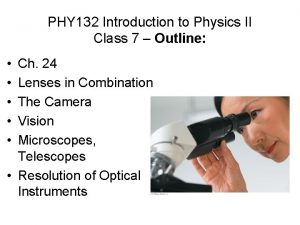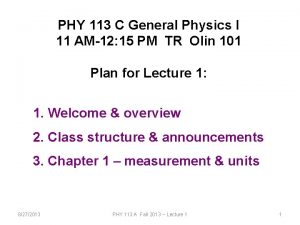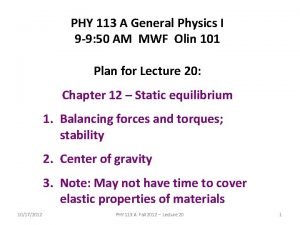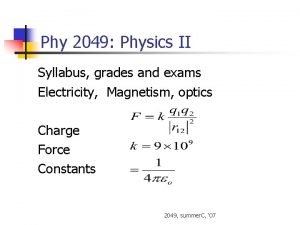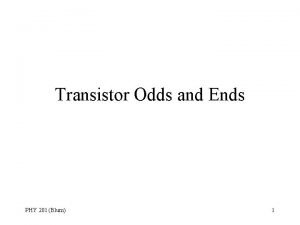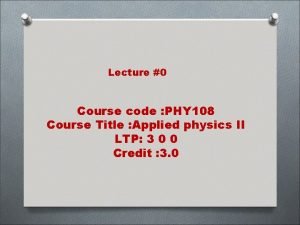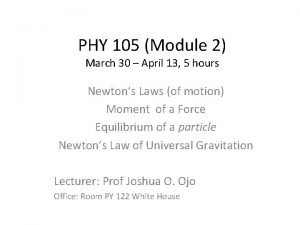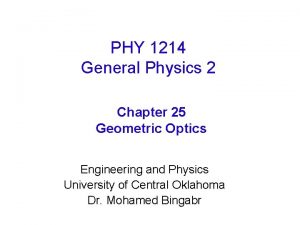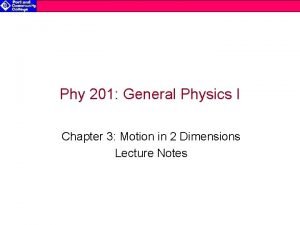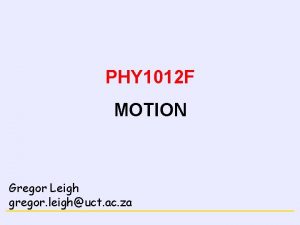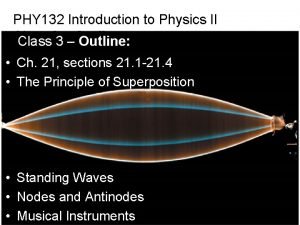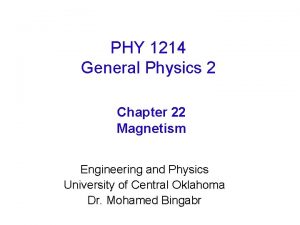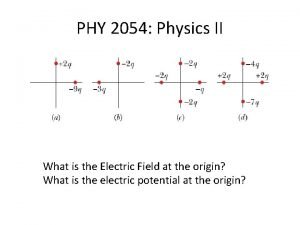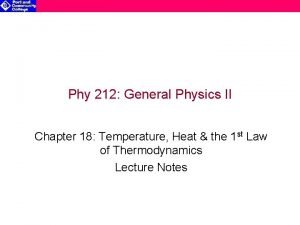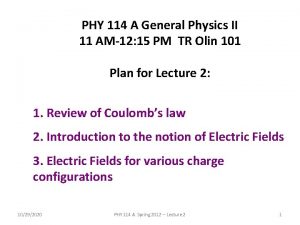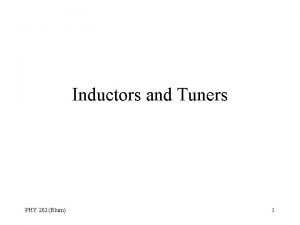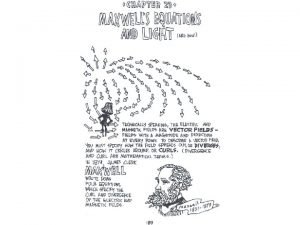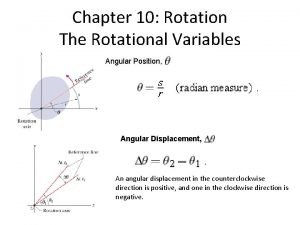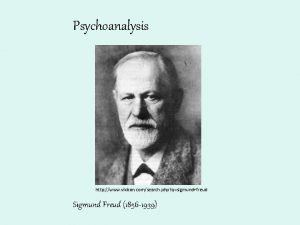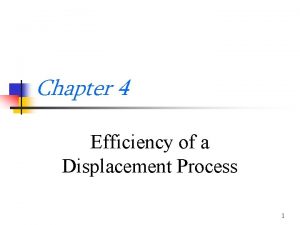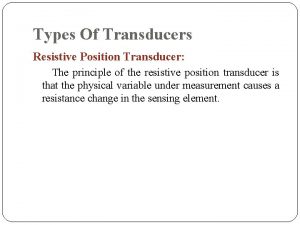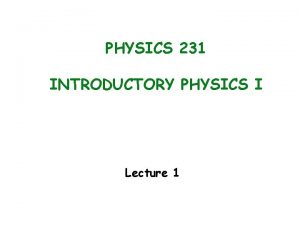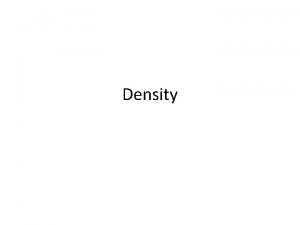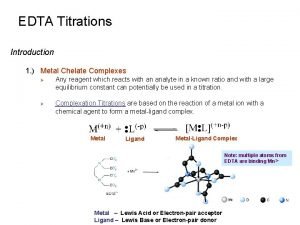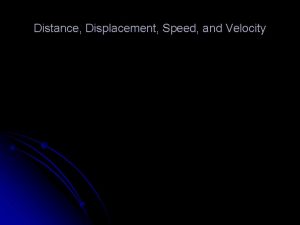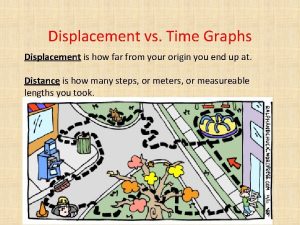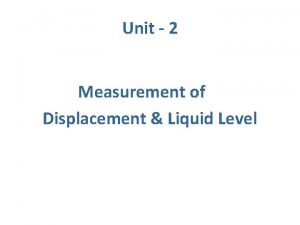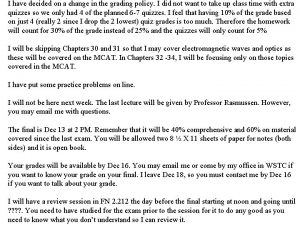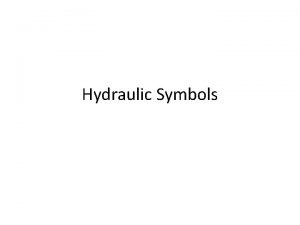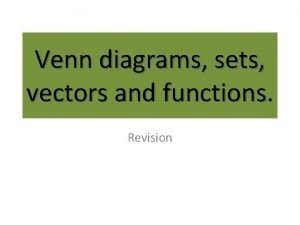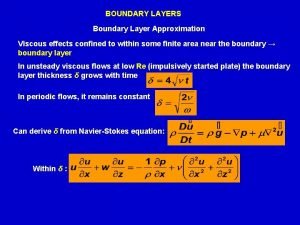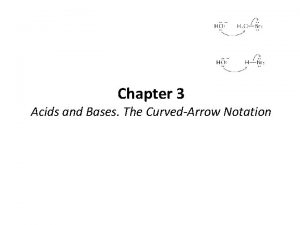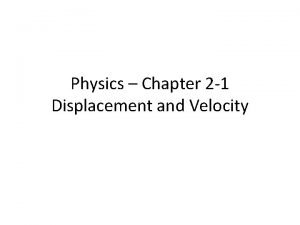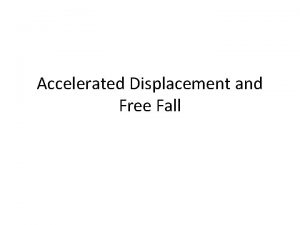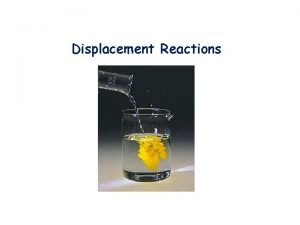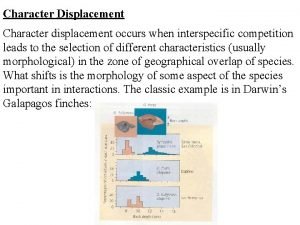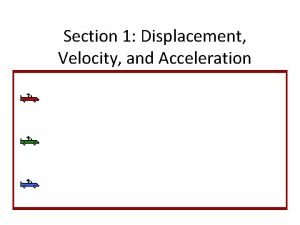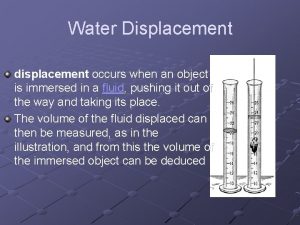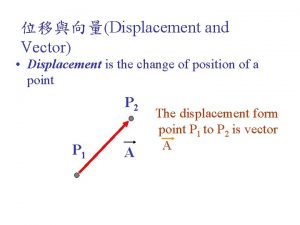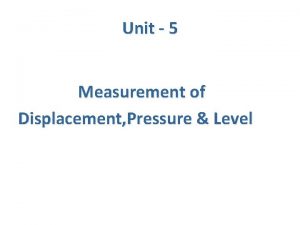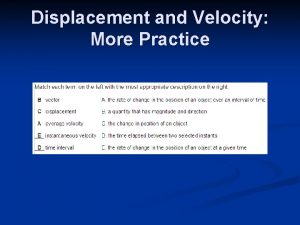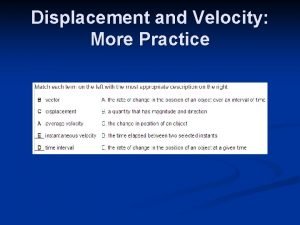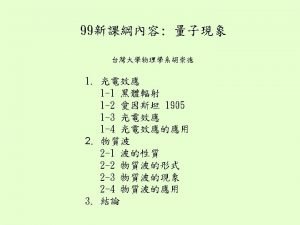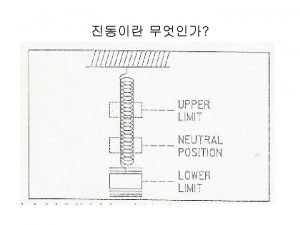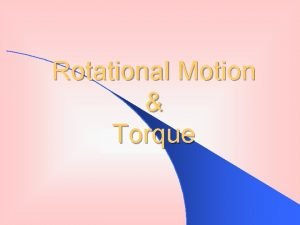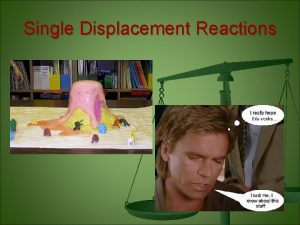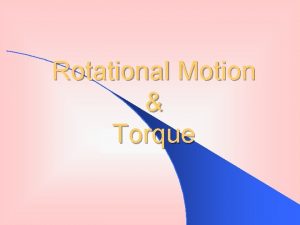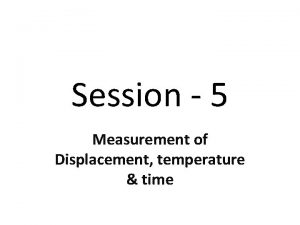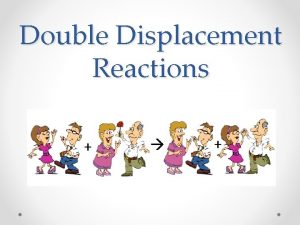PHY 101 Lecture 2 2 1 Displacement 2
































































- Slides: 64

PHY 101: Lecture 2 • • 2. 1 Displacement 2. 2 Speed and Velocity 2. 3 Acceleration 2. 4 Equations of Kinematics for Constant Acceleration 2. 5 Applications of the Equations of Kinematics 2. 6 Freely Falling Bodies 2. 7 Graphical Analysis of Velocity and Acceleration

PHY 101: Lecture 2 Kinematics in One Dimension 2. 1 Displacement

Kinematics Definition of Distance • Type of Quantity: Scalar • Total path length traversed in moving from one position to another • Distance depends on path and not on starting and ending points • Symbol: d • SI Unit: meter (m)

Kinematics Distance - Example • What is the distance for each of the following trips? Ø 1. 3 m east, 4 m east Ø 2. 3 m east, 4 m north Ø 3. 3 m east, 4 m west • For each trip, the distance is 7 m

Xi Definition of Initial Position • Type of Quantity: Vector • Initial position of an object is indicted by a position vector, xi, from the origin to the position xi • Magnitude of xi is distance from the origin to position xi • Direction of xi is either + or • Symbol: xi • SI Unit: meter (m) • Note: Subscript f means the final position, xf xi xi

2 -Dimensional Example Position / Free Vectors

Definition of Displacement • Type of Quantity: Vector • Vector drawn from initial position to final position Ø xi + Dx = xf Ø Dx = xf - xi • Magnitude equals shortest distance between initial and final positions Xi • Direction points from initial to final position • Displacement depends on the initial and final positions and not on path length • Symbol: Dx • SI Unit: meter (m) § D is always final value minus initial value DX Xf

Distance / Displacement

Direction of Displacement • Vector nature of displacement is giving by Ø+ sign to indicate displacement in the +x direction, to the right, or east Ø- sign to indicate displacement in the –x direction, to the left, or west • Note: The same is true for position, velocity, and acceleration

Example of + / - Sign • 500 meters in the +x direction is +500 meters • 500 meters in the –x direction is -500 meters

Distance vs. Displacement • An object can move so that the path length (distance) is large but the displacement is zero or small

Displacement – Example 1 • What is the displacement for each of the following situations? Ø 1. 3 m east, 4 m east » Displacement is 7 m east Ø 2. 3 m east, 4 m north » Displacement is 5 m at 530 above +x axis Ø 3. 3 m east, 4 m west » Displacement is 1 m west

Displacement – Example 2 • A student throws a rock straight upward from shoulder level, which is 1. 65 m above the ground • What is the displacement of the rock when it hits the ground? Ø Displacement is a vector that points from the initial position to the final position Ø Initial position is 1. 65 m above the ground Ø Final position is the ground, height 0 m Ø Magnitude of the displacement vector is then 1. 65 m Ø Direction of the displacement vector is downward

PHY 101: Lecture 2 Kinematics in One Dimension 2. 2 Speed and Average Velocity

Definition of Average Speed • Type of Quantity: Scalar • Average Speed = Distance / Time • savg = d / t • Symbol: savg • SI Unit: meter/s (m/s)

What Does Constant Speed Mean? • Ball has initial position xi = 0 m at time ti = 0 • Ball has constant velocity t = 5 m/s • This means that during: Ø 1 st second ball moves 5 m Ø 2 nd second ball moves 5 m Ø 3 rd second ball moves 5 m, and so on … • Position at time t is: Ø t = 0 s, x = 0 m Ø t = 1 s, x = 5 m Ø t = 2 s, x = 10 m Ø t = 3 s, x = 15 m

Average Speed – Example 1 • A race car circles 10 times around an 8 -km track in 1200 s • What is its average speed in m/s? Ødistance traveled is d = 10 x 8 km = 80, 000 m Øt = 1200 s Øsavg = d/t = 80000 / 1200 s = 66. 7 m/s

Average Speed – Example 2 • A motorist drives 150 km from one city to another in 2. 5 h, but makes the return trip in only 2. 0 h • What are the average speeds for Ø (a) Ø (b) each half of the round-trip, and the total trip? • (a) Ø Ø First half of trip average speed = d/t = 150 km/2. 5 h = 60 km/h Second half of trip average speed = d/t = 150 km/2 h = 75 km/h • (b) Ø Entire trip Ø average speed is d/t = (150+150) / (2. 5 + 2) = 66. 67 km/h

Definition of Average Velocity • Type of Quantity: Vector • Average Velocity = Displacement / Time • vavg = Dx/t = (xf – xi)/t • Direction is the same as the direction of displacement • Symbol: vavg • SI Unit: meter/second (m/s)

Average Velocity – Example 1 • A race car circles 10 times around an 8 -km track in 1200 s • What is its average velocity in m/s ØAfter 10 laps, the ending position is the same as the starting position ØTherefore, displacement is zero, even though distance is 80, 000 m ØSince displacement is zero, average velocity is zero.

Average Velocity – Example 2 • Car travels half a lap in 3 seconds along a circle with radius = 150 m • (a) What is the distance traveled by the car? • Distance is the path length = half the circumference of the circle – d = 2 pr/2 = p(150) = 471 m • (b) What is the magnitude of the car’s displacement? – Displacement is the vector from the initial position to the final position – Vector is across the diameter of the circle – Magnitude of displacement is 2 x 150 = 300 m • (c) What is the average speed of the car? – Average speed s = distance / time = 471. 24 m / 3 s = 157 m/s • (d) What is the magnitude of the average velocity of the car? – Average velocity = displacement / time = 300 m / 3 s = 100 m/s

Average Velocity – Example 3 • A car travels a full lap in 5 seconds along a circle that has a radius of 150 m? • (a) What is the distance traveled by the car? • Distance is the path length = circumference of the circle • d = 2 pr = 2 p(150) = 942 m • (b) What is the magnitude of the car’s displacement? • Displacement is vector from the initial position to the final position • The initial and final positions are at the same location • Magnitude of displacement vector is zero. • (c) What is the average speed of the car? • Average speed s = distance / time = 942. 48 m / 5 s = 189 m/s • (d) What is magnitude of the average velocity of car? • Average velocity = displacement / time = 0 m / 5 s = 0 m/s

PHY 101: Lecture 2 Kinematics in One Dimension 2. 3 Acceleration

Definition of Average Acceleration • Type of Quantity: Vector • Acceleration = Change in Velocity / Time • aavg = Dv/t = (vf – vi)/t • Symbol: aavg • SI Unit: meter/second 2 (m/s 2) • Note: When velocity and acceleration have opposite direction (signs), the object is decelerating

Average Acceleration – Example 1 • An automobile traveling at 8 m/s along a straight, level road accelerates to 20 m/s in 6. 00 s • What is the magnitude of the auto’s average acceleration? Øaverage acceleration = Ø(vf – vi)/t = (20 – 8) / 6 = 2 m/s 2

Average Acceleration – Example 2 • Motorcycle has a constant acceleration of 2. 5 m/s 2 • Both the velocity and acceleration of the motorcycle point in the same direction • How much time is required for the motorcycle to change its velocity from 21 to 31 m/s. Ø aavg = (vf – vi) / t Ø 2. 5 m/s 2 = (31 m/s – 21 m/s) / t Ø t = 10 / 2. 5 = 4 s

PHY 101: Lecture 2 Kinematics in One Dimension 2. 4 Equations of Kinematics for Constant Acceleration

Equation of Motion • Equations that give x, v, and a as functions of t Ø x = f(t) Ø v = g(t) Ø a = h(t) • We will look at a special case where a is constant Ø a = aavg = constant independent of time • We can also eliminate t from x and v to obtain Ø v = j(x)

Development of Equations of Motion • a = aavg = (vf – vi) / t • vf = vi + at (constant acceleration) • vavg = (xf – xi) / t • xf = xi + vavgt • vavg = ½ (vf + vi) (constant acceleration)

Equations of Motion • vf = vi + at • xf = xi + vit + (1/2)at 2 • vf 2 = vi 2 + 2 a(xf – xi) • These are vector equations • xi, xf, vi, vf, a, and t can be + or -

Scalar vs. Vector Magnitude • Scalar can be negative or positive – For example, temperature, work, and energy can be negative or positive • Magnitude of a vector is always positive – For example, displacement, velocity, and acceleration magnitude is always positive • Negative sign on a magnitude is an indication that the vector points in the negative (opposite) direction

PHY 101: Lecture 2 Kinematics in One Dimension 2. 5 Applications of the Equations of Kinematics

Equations of Motion – Example 1 • • Basketball player starts from rest and accelerates uniformly to speed 6. 0 m/s in 1. 5 s What distance does the player run? vf = vi + at xf = xi + vit + ½at 2 vf 2 = vi 2 + 2 a(xf – xi) xi = 0 xf = ? vi = 0 vf = 6. 0 a = ? t = 1. 5 6=0+a(1. 5) Equation has a (1 st) xf=0+0(1. 5)+½a(1. 5)2 Equation has 2 unknowns, xf, a (2 nd) 62=02+2 a(xf– 0) Equation has two unknowns, xf, a 6=0+a(1. 5); a = 6/1. 5 = 4 m/s 2 xf=0+0(1. 5)+½(4)(1. 5)2 = 4. 5 m/s

Equations of Motion–Example 2 a • Car accelerates from rest at rate of 2. 0 m/s 2 for 5. 0 s • (a) What is the speed of the car at the end of that time? vf = vi + at xf = xi + vit + ½at 2 vf 2 = vi 2 + 2 a(xf – xi) xi = 0 xf = ? vi = 0 vf = ? a = 2. 0 t = 5. 0 vf=0+2(5) xf=0+0(5)+½(2)(5)2 vf 2=02+2(2)(xf– 0) vf=0+2(5)=10 m/s Equation has vf Equation has xf Equation has two unknowns, xf, vf

Equation of Motion – Example 2 b • Car accelerates from rest at rate of 2. 0 m/s 2 for 5. 0 s • (b) How far does the car travel in this time? vf = vi + at xf = xi + vit + ½at 2 vf 2 = vi 2 + 2 a(xf – xi) xi = 0 xf = ? vi = 0 vf = 10 a = 2. 0 t = 5. 0 10=0+2(5) Can’t use Equation xf=0+0(5)+½(2)(5)2 Equation has xf 102=02+2(2)(xf– 0)Equation has xf xf=0+0(5)+½(2)(5)2 = 25 m

Equation of Motion – Example 3 a • A car traveling at 15 m/s stops in 35 m • (a) What is the acceleration? vf = vi + at xf = xi + vit + ½at 2 vf 2 = vi 2 + 2 a(xf – xi) xi = 0 xf = 35 vi = 15 vf = 0 a = ? t=? 0=15+at 35=0+15 t+½(a)(t)2 02=152+2 a(35– 0) a = -225/70 = -3. 2 m/s 2 Equation has a, t Equation has a

Motion – Example 3 b • A car traveling at 15 m/s stops in 35 m • (b) What is time during this deceleration until car stops? vf = vi + at xf = xi + vit + ½at 2 vf 2 = vi 2 + 2 a(xf – xi) xi = 0 xf = 35 vi = 15 vf = 0 a = -3. 2 t = ? 0=15 -3. 2 t 35=0+15 t+½(-3. 2)(t)2 02=152+2(-3. 2)(35– 0) 0=15 -3. 2 t t = -15/-3. 2 = 4. 67 s Equation has t Can’t use equation

Equation of Motion – Example 4 • A plane accelerates at 8 m/s 2 on a runway that is 500 m long • The take off speed of the plane is 80 m/sec • Can the plane takeoff? vf = vi + at xf = xi + vit + ½at 2 vf 2 = vi 2 + 2 a(xf – xi) xi = 0 xf = 500 vi = 0 vf = ? a=8 t=? vf=0+8 t Equation has vf, t 500=0+0 t+½(8)(t)2 Equation has t vf 2=02+2(8)(500– 0) Equation has vf 2=02+2(8)(500– 0) = 500(16) vf=sqrt(500(16) = 89. 4 m/s • The plane can takeoff

Equation of Motion – Example 5 • A plane accelerates at 8 m/s 2 • The take off speed of the plane is 80 m/sec • What is minimum length of run way for plane to reach take off speed? vf = vi + at xf = xi + vit + ½at 2 vf 2 = vi 2 + 2 a(xf – xi) xi = 0 xf = ? vi = 0 vf = 80 a = 8 t=? 80=0+8 t xf=0+0 t+½(8)(t)2 802=02+2(8)(xf– 0) xf=6400/16 = 400 m Equation has t Equation has xf, t Equation has xf

Eq. of Motion – Example 6 Bull • • Bull runs 8 m/sec A boy at rest has a head start of 12 m When he sees the bull he accelerates at 2 m/s 2 Does the bull catch the boy? vf = vi + at xf = xi + vit + ½at 2 vf 2 = vi 2 + 2 a(xf – xi) xi = 0 xf = ? vi = 8 vf = 8 a = 0 t = ? 8=8+0 t Can’t use this equation xf=0+8 t+½(0)(t)2 Equation has xf, t 82=82+2(0)(xf– 0) Can’t use this equation

Eq. of Motion – Example 6 Boy • • Bull runs 8 m/sec A boy at rest has a head start of 12 m When he sees the bull he accelerates at 2 m/s 2 Does the bull catch the boy? vf = vi + at xf = xi + vit + ½at 2 vf 2 = vi 2 + 2 a(xf – xi) xi = 12 xf = ? vi = 0 vf = ? a = 2 t=? vf=0+2 t Equation has vf, t xf=12+0 t+½(2)(t)2 Equation has xf, t vf 2=02+2(2)(xf– 12) Equation has xf, vf

Example 6 Bull / Boy • • Bull runs 8 m/sec A boy at rest has a head start of 12 m When he sees the bull he accelerates at 2 m/s 2 Does the bull catch the boy? xf=0+8 t+½(0)(t)2 (from Bull equations) xf=12+0 t+½(2)(t)2 (from Boy equations) They catch up to each other when the boy xf = bull xf 8 t=12+t 2 t 2 -8 t+12=0 Factor (t-2)(t-6) = 0 • Bull catches boy at 2 s and 6 s • 2 s is bull catching up to the boy • 6 s is the accelerating boy catching up to the bull

PHY 101: Lecture 2 Kinematics in One Dimension 2. 6 Freely Falling Bodies

Free Fall • • Objects falling vertically Near the surface of the earth Acceleration due to gravity a = -9. 8 m/s 2

Free Fall – Example 1 • A bomb is dropped from 6000 m • With what speed does it hit the ground? vf = vi + at yf = yi + vit + ½at 2 vf 2 = vi 2 + 2 a(yf – yi) yi = 6000 yf = 0 vi = 0 vf = ? a = -9. 8 t=? vf = 0 – 9. 8 t 0 = 6000 + 0 t + ½ (-9. 8)t 2 vf 2 = 02 + 2(-9. 8) (0 – 6000) vf 2 = 02 + 2(-9. 8)(-6000) vf = sqrt(117600) = -343 m/s Equation has vf, t Equation has vf

Free Fall – Example 2 a • A student drops a ball from the top of a tall building • It takes 2. 8 s for the ball to reach the ground • (a) What is the height of the building? vf = vi + at yf = yi + vit + ½at 2 vf 2 = vi 2 + 2 a(yf – yi) yi = ? yf = 0 vi = 0 vf = ? a = -9. 8 t = 2. 8 vf = 0 – 9. 8(2. 8) Equation has vf 0 = yi + 0(2. 8) + ½(-9. 8)(2. 8)2 Equation has yi vf 2 = 02 + 2(-9. 8) (0 – yi) Equation has yi, vf 0 = yi + (1/2)(-9. 8)(2. 8)2 yi = 38. 4 m

Free Fall – Example 2 b • A student drops a ball from the top of a tall building • It takes 2. 8 s for the ball to reach the ground • (b) What was the ball’s velocity just before hitting the ground? vf = vi + at yf = yi + vit + ½at 2 vf 2 = vi 2 + 2 a(yf – yi) yi = 38. 4 yf = 0 vi = 0 vf = ? a = -9. 8 t = 2. 8 vf = 0 – 9. 8(2. 8) Equation has vf 0 = 38. 4 + 0(2. 8) + ½(-9. 8)(2. 8)2 Can’t use equation vf 2 = 02 + 2(-9. 8) (0 – 38. 4) Equation has vf = 0 – 9. 8(2. 8) = -27. 4 m/s (- means downward)

Free Fall – Example 3 • Boy throws stone straight upward with an initial velocity of 15 m/s • What maximum height will stone reach before falling back down? • At the maximum height vy = 0 vf = vi + at yf = yi + vit + ½at 2 vf 2 = vi 2 + 2 a(yf – yi) yi = 0 yf = ? vi = 15 vf = 0 a = -9. 8 t=? 0 = 15 – 9. 8 t Equation has t yf = 0 + 15 t + ½(-9. 8)t 2 Equation has yf, t 02 = 152 + 2(-9. 8) (yf – 0) Equation has yf 02 = 152 + 2(-9. 8) (yf – 0) yf = -152/2/-9. 8 = 11. 48 m

Free Fall – Example 4 • Ball thrown upwards at 40 m/s. Calculate time to reach 35 m vf = vi + at yf = yi + vit + ½at 2 vf 2 = vi 2 + 2 a(yf – yi) yi = 0 yf = 35 vi = 40 vf = ? a = -9. 8 t=? vf = 40 – 9. 8 t Equation has vf, t (2 nd) 35 = 0 + 40 t + ½(-9. 8)t 2 Equation has t vf 2 = 402 + 2(-9. 8) (35 – 0) Equation has vf (1 st) vf 2 = 402 + 2(-9. 8) (35 – 0) = 914 vf = +30. 2 or -30. 2 = 40 – 9. 8 t t = (30. 2 – 40) / (-9. 8) = 1. 0 s (time on the way up)

Free Fall – Example 5 Ball 1 • A ball is dropped from rest • Four seconds later, a second ball is thrown down at 50 m/s Calculate when and where the two balls meet vf = vi + at yf = yi + vit + ½at 2 vf 2 = vi 2 + 2 a(yf – yi) yi = 0 yf = ? vi = 0 vf = ? a = -9. 8 t=? vf = 0 – 9. 8 t yf = 0 + 0 t + ½(-9. 8)t 2 vf 2 = 02 + 2(-9. 8) (yf – 0) Equation has vf, t Equation has yf, vf

Free Fall – Example 5 Ball 2 • A ball is dropped from rest • Four seconds later, a second ball is thrown down at 50 m/s Calculate when and where the two balls meet vf = vi + at yf = yi + vit + ½at 2 vf 2 = vi 2 + 2 a(yf – yi) yi = 0 yf = ? vi = -50 vf = ? a = -9. 8 t=t– 4? vf = -50– 9. 8(t-4) yf = 0 -50(t-4)+½(-9. 8)(t-4)2 vf 2 = 502+2(-9. 8) (yf – 0) Equation has vf, t Equation has yf, vf

Free Fall – Example 5 Balls 1 and 2 • A ball is dropped from rest • Four seconds later, a second ball is thrown down at 50 m/s • Calculate when and where two balls meet yf = 0 + 0 t + ½(-9. 8)t 2 (from ball 1) yf = 0+50(t-4)+½(-9. 8)(t-4)2 (from ball 2) Substitute equation 1 into equation 2 -4. 9 t 2 = -50(t-4) – 4. 9(t-4)2 -4. 9 t 2 = -50 t + 200 – 4. 9 t 2 +39. 4 t – 78. 4 -10. 6 t + 121. 6 = -0 t = -121. 6 / -10. 6 = 11. 4 s

Free Fall – Example 6 a • From tower 100 m high, ball is thrown up with speed of 40 m/s • (a) How high does it rise? vf = vi + at yf = yi + vit + ½at 2 vf 2 = vi 2 + 2 a(yf – yi) yi = 100 yf = ? vi = 40 vf = 0 a = -9. 8 t=? 0 = 40 – 9. 8 t Equation has t yf = 100 + 40 t + ½(-9. 8)t 2 Equation has yf, t 02 = 402+2(-9. 8)(yf– 100) Equation has yf 02 = 402+2(-9. 8)(yf– 100) yf = (-1600/2/-9. 8) + 100 = 181. 6 m

Free Fall – Example 6 b • From tower 100 m high, ball is thrown up with speed of 40 m/s • (b) When does it hit ground? vf = vi + at yf = yi + vit + ½at 2 vf 2 = vi 2 + 2 a(yf – yi) yi = 100 yf = 0 vi = 40 vf = ? a = -9. 8 t=? vf = 40 – 9. 8 t Equation has vf, t 0 = 100 + 40 t + ½(-9. 8)t 2 Equation has t vf 2 = 402+2(-9. 8)(0– 100) Equation has vf 0 = 100 + 40 t + ½(-9. 8)t 2 -4. 9 t 2 + 40 t + 100 = 0 (Use quadratic equation) t = 10. 2 s

Free Fall – Example 6 c • From tower 100 m high, ball is thrown up with speed of 40 m/s • (c) How fast is it moving at the ground ? vf = vi + at yf = yi + vit + ½at 2 vf 2 = vi 2 + 2 a(yf – yi) yi = 100 yf = 0 vi = 40 vf = ? a = -9. 8 t = 10. 2 vf = 40 – 9. 8(10. 2) Equation has vf 0 = 100+40(10. 2)+½(-9. 8)(10. 2)2 Can’t use equation vf 2 = 402+2(-9. 8)(0– 100) Equation has vf 2 = 402+2(-9. 8)(0– 100) = 1600 + 1960 = 3560 vf = -59. 7 m/s

PHY 101: Lecture 2 Kinematics in One Dimension 2. 7 Graphical Analysis of Velocity and Acceleration

Graphical Analysis 1 • Velocity = 0 Acceleration = 0 • Horizontal line on P-T graph: velocity = 0 Time 0 1 2 3 4 5 Pos 5 5 5

Graphical Analysis 2 • Velocity = 1 Acceleration = 0 • Sloping line on P-T graph: velocity <> 0 Time 0 1 2 3 4 5 Pos 0 1 2 3 4 5

Graphical Analysis 3 • Velocity = 2 Acceleration = 0 • Steeper slope means greater velocity Time 0 1 2 3 4 5 Pos 0 2 4 6 8 10

Graphical Analysis 4 • Velocity = -1 Acceleration = 0 • Negative slope means velocity in opposite direction Time 0 1 2 3 4 5 Pos 0 -1 -2 -3 -4 -5

Graphical Analysis 5 • Velocity = 1 Acceleration = 1 • Curving line on P-T graph: acceleration <> 0 Time 0 1 2 3 4 5 Pos 0 1. 5 4 7. 5 12 17. 5

Speed vs Average Speed (Charts) Time (min) Position (m) Time (min) Speed (m/min) 0 0 1 400 0. 5 400 2 1200 1. 5 800 3 2700 2. 5 1500 4 2900 3. 5 200 5 2900 4. 5 0 6 4000 5. 5 1100 7 5500 6. 5 1500 8 7200 7. 5 1700 9 7300 8. 5 100

Speed vs. Avg. Speed (Graphs)

Speed vs. Average Speed • Prior charts & graphs show trip of car • During trip the velocity changes • Average velocity remains constant during the trip • Average velocity produces same final position as does the varying velocity
 Phy 132 lecture 10: ch30
Phy 132 lecture 10: ch30 Single displacement vs double displacement
Single displacement vs double displacement 01:640:244 lecture notes - lecture 15: plat, idah, farad
01:640:244 lecture notes - lecture 15: plat, idah, farad Phy101 lecture 1
Phy101 lecture 1 Physics 101 lecture notes pdf
Physics 101 lecture notes pdf Physics 101 lecture
Physics 101 lecture Waves pdf
Waves pdf Lecture 101
Lecture 101 Phy 1214
Phy 1214 2012 phy
2012 phy Phy theorem
Phy theorem Phy 2049
Phy 2049 Accommodation eye
Accommodation eye General physics 1 measurements
General physics 1 measurements Law of motion
Law of motion Phy 231 msu
Phy 231 msu Life phy
Life phy Phy
Phy Phy108
Phy108 Phy113
Phy113 Phy-105 5 discussion
Phy-105 5 discussion Real image
Real image Phy 2049
Phy 2049 Vx=vox+axt
Vx=vox+axt Phy
Phy Great orthogonality theorem in group theory
Great orthogonality theorem in group theory Rikard blunck
Rikard blunck Atm packet phy
Atm packet phy Ddr phy architecture
Ddr phy architecture Phy tgen
Phy tgen Phy 121 asu
Phy 121 asu Loncapa fsu
Loncapa fsu Phy 1214
Phy 1214 Physics 2
Physics 2 Phy 132
Phy 132 Rotational statics
Rotational statics Phy 1214
Phy 1214 Fizik ii
Fizik ii Phy 205
Phy 205 Phy 212
Phy 212 Phy
Phy Phy 131 past papers
Phy 131 past papers Phy
Phy Phy
Phy Displacement current
Displacement current Angular displacement variable
Angular displacement variable Define displacement method
Define displacement method Displacement vs sublimation
Displacement vs sublimation Displacement efficiency formula
Displacement efficiency formula Resistive transducer application
Resistive transducer application Distance vs. displacement
Distance vs. displacement Water displacement formula
Water displacement formula Slidetodoc.com
Slidetodoc.com Types of suppositories
Types of suppositories Distance vs displacement
Distance vs displacement In a drill during basketball practice displacement
In a drill during basketball practice displacement Displacement
Displacement Displacement current is continuous:
Displacement current is continuous: Unidirectional pump symbol
Unidirectional pump symbol Draw a venn diagram of a ∩ b
Draw a venn diagram of a ∩ b Left uterine displacement
Left uterine displacement Internal displacement
Internal displacement Displacement thickness
Displacement thickness Electron pair displacement reaction
Electron pair displacement reaction Two students walk in the same direction
Two students walk in the same direction
